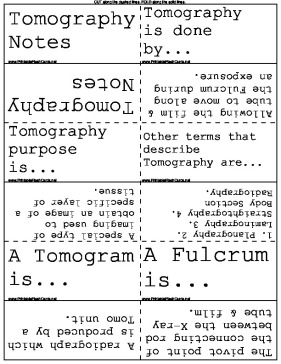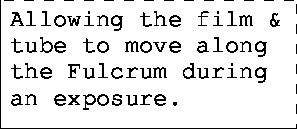

Tomography is a form of imaging an object in three dimensions and can be used for anatomy.
There are 19 flash cards in this set (4 pages to print.)
To use:
1. Print out the cards.
2. Cut along the dashed lines.
3. Fold along the solid lines.
Sample flash cards in this set:




| Questions | Answers |
|---|---|
| Tomography Notes | Tomography Notes |
| Tomography is done by... | Allowing the film & tube to move along the Fulcrum during an exposure. |
| Tomography purpose is... | A special type of imaging used to obtain an image of a specific layer of tissue. |
| Other terms that describe Tomography are... | 1. Planography 2. Laminography 3. Straightography 4. Body Section Radiography. |
| A Tomogram is... | A radiograph which is produced by a Tomo unit. |
| A Fulcrum is... | The pivot point of the connecting rod between the X-ray tube & film. |
| The Fulcrum Level is... | The distance measured in CM or Inches from the top of the table to the Fulcrum. |
| An Object Plane or (Focal Plane) is... | The plane in which the object is clear & in focus. |
| The Sectional Thickness is... | The thickness of an object or Focal Plane. |
| An Exposure Angle is... | The angle resulting from X-ray beam improvement. |
| Tube movement is... | The distance the tube travels. |
| Amplitude is... | The speed of the tube movement. |
| Tube Trajectory is... | The blurring pattern of the tube movement. |
| Blur is... | The area of distortion of objects outside the object plane. |
| Blur Margin is... | The outer edge of the blurred object. |
| Different Tube Trajectories are... | 1. Linear - The least complex 2. Elliptical 3. Circular 4. Spiral - Complex 5. Hypocycloidal - Most Complex |
| Fulcrum Types are... | 1. Fixed - Are most often used with multi-directional Tomo units. 2. Variable - The Fulcrum level can be moved in relation to the patient. |
| 2 ways to determine the Fulcrum level are... | 1. Take 2 X-rays 90 degrees apart. 2. Measure the desired part & divide by 3. (Calipers for IVP's) |
| Influencing factors that control Blur are... | 1. Distance the object is from the object plane. 2. Exposure angles. (more angle = more Blur) 3. Distance the object is from the IR 4. Tube Trajectory |